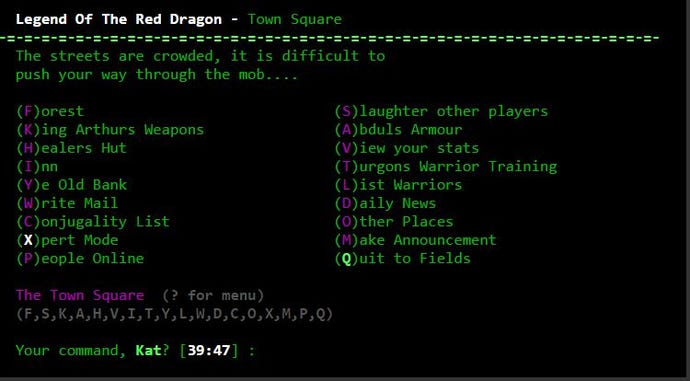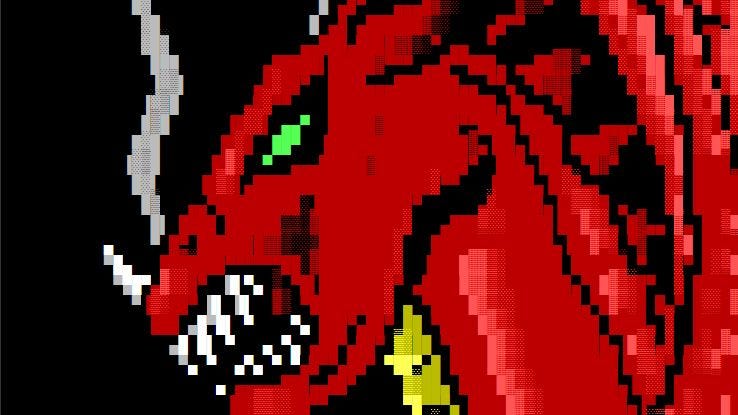The RPGs that made us: Legend Of The Red Dragon
We'll get to the dragon killing. First, we flirt.
Growing up in the late 80s and early 90s, I was lucky enough to have a dad who happened to be in IT. It meant that from an early age I was banging away at keyboards, playing games like MadMaze on a laptop the size of a briefcase. I eventually fell into to the nascent world of online gaming, which was how I discovered Legend Of The Red Dragon, or LoRD as it’s often known.
Developed by Seth Robinson, a teenager with a bare minimum of programming knowledge, Legend Of The Red Dragon was an extremely popular example of the “Door Game,” a sub-genre of social gaming that grew out of a desire to cultivate a community around online bulletin board services. BBSes were a fixture of the pre-internet days of the 1980s and early 90s, a place to gather, play social games, and download new demos. I’d dial in on my blazing fast 19.2k modem, suffer through the screech and groan of the connection, and then dive into Trade Wars and Legend Of The Red Dragon, which were the Facebook games of their day owing to their time-limited nature and social hooks.
Legend Of The Red Dragon was both my first taste of roleplaying and online gaming at large, teaching me the joys of grinding for experience and loot while giving me a glimpse of the connected world to come. I didn’t know much about RPGs at that time, but I had an inkling that the accurately-named Death Sword sitting in the shop was probably a good thing to have, and that it would be fun to chop up other players with it. It was an experience unlike any on console at that time, and the novelty of playing in a large community drew me in - along with thousands of others.
Today, Legend Of The Red Dragon and the BBS Door Game sub-genre at large is half-forgotten, which is one reason I’m blatantly cribbing from Netflix’s recent series of pop culture documentaries in creating what may or may not be an ongoing mini-series (we’ll see). When we think of the dawn of online roleplaying we generally cast our minds back to World Of Warcraft, EverQuest, and Ultima Online, or if you’re a little older, the MUDs and MUCKs of the 80s and 90s. But Legend Of The Red Dragon also deserves to be part of that conversation, if only because it was willing to lean into a topic that elicited nervous titters from game developers in the 90s and even into the 2000s: sex.

In Legend Of The Red Dragon, you play as a faceless man or woman on a quest to slay the titular wyrm. Wielding little more than a (scary-looking) stick, you stride into a town filled with shops, an inn, and a training dojo, with a monster-filled forest just beyond. When you’re not grinding levels, you can battle with other players, flirt with Seth the Bard, and contract the odd STD.
Its heyday was in the early 90s, where it thrived alongside MUDs on one side and Neverwinter Nights (no, not that Neverwinter Nights) on the other. Compared to its contemporaries, Legend Of The Red Dragon was straightforward and easy to understand, which was to its benefit. You would head into the forest and kill monsters for gold and experience, which you could then use to buy better weapons and armor. Advancement came via beating the master of the local training dojo. Once you reached a high enough level, you could take on the Red Dragon itself.
Adding color to the experience were special events in the forest, where you might encounter a fairy, or maybe a spooky decapitated head with a story to tell. You could take on CPU-controlled versions of other players in the field, or bribe the innkeeper and kill them while they slept. And as I already mentioned, there was the flirting.
"Legend Of The Red Dragon was willing to lean into a topic that elicited nervous titters from game developers in the 90s: sex."
Legend Of The Red Dragon was able to implement the sort of roleplaying that was mainly limited to chatrooms in this period (and still is to a great extent), underlining the baudier elements of fantasy fiction. Robinson got the initial idea from a futuristic casino game where it was possible to spend the night with characters you met, and soon implemented it into Legend Of The Red Dragon. It wasn’t long before it began to grow in complexity, incorporating everything from marriage to raising kids.
“I wouldn't have bothered if it was simply a thing with an NPC, probably," Robinson said in a 2008 interview, "but actually getting married to a real player and then sharing the event had a lot more meaning, [and] was more engrossing."
All of this admittedly flew over my head when I was dialing into SmartStuff to play Legend Of The Red Dragon in 1993. Playing with my friends at school, we were in a race to see who could defeat the Red Dragon first. Unfortunately for me, I fell behind when I opted to upgrade to a Blood Sword rather than invest in new armor, which resulted in me taking far too much damage from high-level monsters in the forest. It was an abject lesson in where my priorities should lie, one that still rattles around my brain to this day when I wander into a shop to buy some new gear.

I was also hampered by the turn limit, an early limitation that presaged the mechanics that would come to dominate free-to-play mobile games. The turn limit in Legend Of The Red Dragon was mostly there to keep people from grinding ad infinitum, killing the Red Dragon, and then quitting, but knowing that didn’t make it any less annoying. I eventually discovered that if I disconnected the modem at just the right time, I could get all my turns back and go again, which made me feel like the most brilliant of budding 11-year-old roleplayers.
Like everyone else I eventually moved on from Legend Of The Red Dragon to more advanced online games. Robinson himself would become engrossed in Ultima Online, playing all-night sessions with friends in the barn he purchased with the money from LorD. He eventually made Legend Of The Red Dragon 2, a graphical adventure referred to as a “unwholesome marriage of Ultima, ZZT, and Habitat,” but it never captured quite the same audience as Legend Of The Red Dragon. In the end Robinson sold both games to a company called Metropolis Gameport and cashed out.

Metropolis shut down all of its BBS servers in 2008, but it’s still possible to play Legend Of The Red Dragon thanks to a user named "falknhayn", who created Gear LoRD by re-writing a version that had been running through an MS-DOS emulator for nearly 20 years before finally going dormant in 2019. Gear LoRD features a handful of changes from the original game, including three unique realms and modern amenities like browser and touchscreen support. For nostalgia’s sake, I rolled up a new character last week and ventured back into the forest to battle creatures great and small. I was doing alright into someone called “Bran the Warrior” surprised me with a sharp blow from the short sword and, well, yeah.


